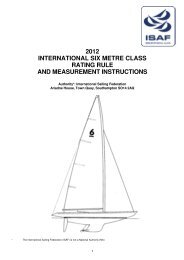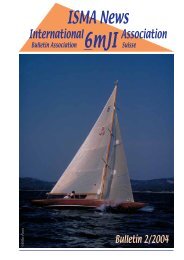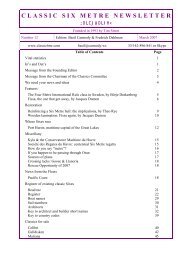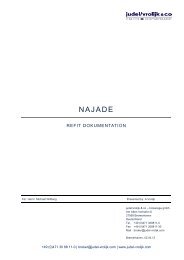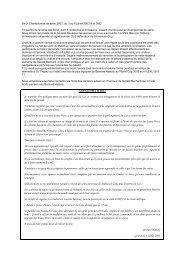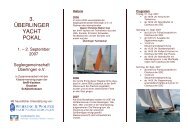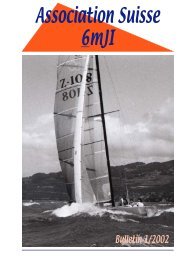CLASSIC SIX METRE NEWSLETTER
CLASSIC SIX METRE NEWSLETTER
CLASSIC SIX METRE NEWSLETTER
You also want an ePaper? Increase the reach of your titles
YUMPU automatically turns print PDFs into web optimized ePapers that Google loves.
Mast Step: A stainless steel band under the mast step is required to take the force of the<br />
diagonals. This arrangement will create a complete triangular space frame, distributing<br />
the loads over a large area of the hull, thus allowing maximum rig tension. The lateral<br />
deck beam structure in this area must also be robust.<br />
With these modifications, the keel no longer has to bear the tension of the rigging.<br />
3. Bow section: We favour a foil forestay with furler. Normally, we anchor the forestay<br />
to underside of the stem.<br />
Stainless steel furler mounting: It is important to ensure that it is fully installed before<br />
applying full loads to the running backstays. This approach avoids loading the deck and<br />
can be used even if the frames and the inner stem are not in perfect condition.<br />
4. Decks and deck beams: A plywood sub-deck greatly strengthens the deck. The<br />
original deck beams of wooden Sixes are not strong enough to withstand the loads<br />
imposed by modern sails. The camber of the deck increases its strength. Compared<br />
to a deck with a good camber, a flat deck will withstand less compression before<br />
collapsing.<br />
Comments, by Kimo Mackey<br />
I consider it worth stressing the very significant increase in hull strength which results from<br />
the topside planks being well glued to one another at the edges for the full length of the hull<br />
Theo Rye very correctly points this out, but I wanted to emphasize how substantial is the<br />
contribution to longitudinal strength of the structure.<br />
Brion Pope’s “plywood ring bulkhead and diagonal tie rod solution” for opposing the<br />
athwartship shroud loads is without defect structurally, but some of us may find this solution<br />
less than ideal for application on a Classic 6mR (“plywood ring bulkhead?….I don’t think<br />
so”). My objections to this solution are not only aesthetic but practical as well, because the<br />
arrangement hugely restricts access into the bow of the boat (about the only place to store all<br />
your clobber).<br />
I used to believe that the ring bulkhead – diagonal tie rod solution was the only one which<br />
could adequately resist high shroud tensions, but I have recently had experience with a very<br />
good system done by Red Sky Craft (Kotka, Finland) on Henrik Andersin's May Be VI (and<br />
also on Fridolin). In this system the "chainplate" consists of a series of stainless steel straps<br />
(4-5 per side) which radiate far below the sheer strake/clamp and continue deep into the hull<br />
(all the way to the bilge in a fanning pattern). The straps are through fastened as they pass<br />
over each frame and they are also fastened to a stringer (not part of the original structure but<br />
added to increase strength in the way Theo has recommended). In this system the diagonal<br />
rods are not used so there is free unobstructed passage forward alongside the mast. As in the<br />
- 15-



